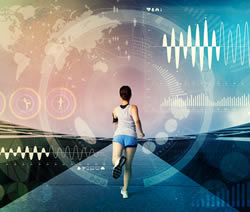Paul Biegler* says that sensor expertise drawn from animal analysis may very well be used to trace human well being by our gadgets.

Sudden findings from sensors implanted in animals, a follow generally known as biologging, ought to trigger a seismic shift in how wearable sensors are used to advertise well being in people.
That’s the conclusion of a global group of scientists from the Massachusetts Institute of Expertise within the US, King Abdullah College of Science and Expertise in Saudi Arabia, and others from Spain and Australia, in a perspective piece revealed within the journal ACS Sensors.
The group says animals have been fitted with sensors to measure only one or two behaviours, but scientists have gained dramatic and unexpected insights right into a wealth of different habits.
A living proof is the jaw sensor.
To the uninitiated, this tiny machine, which has been implanted in penguins, sea lions and dolphins, appears solely in a position to know if the jaw is shifting up or down.
However by drilling down on the dimensions and frequency of indicators, scientists have labored out when the animal is chewing, swallowing or capturing prey.
Additionally they understand how a lot and what sort of meals it eats and the way lengthy it feeds.
Which is ok and dandy for those who’re within the gustatory habits of, say, the Northern rockhopper penguin.
However the scientists argue additionally it is of essential significance for the rising science of wearable well being monitoring, not least as a result of most of us are already sensor-enabled.
“[R]oughly three billion individuals owned smartphones in 2018, successfully already being tagged with a subset of sensors,” Michael Lee and co-authors write.
Researchers have used smartphone tapping behaviour to foretell Parkinson’s illness, analysed textual content and e-mail knowledge to detect depressed speech and even used the cellphone’s digital camera to measure coronary heart price by have a look at pores and skin color modifications within the finger.
These are beautiful advances, however a lot of them come from a really targeted tackle the info.
It’s an method, the authors argue, that might profit from being rather less inflexible and a bit of extra laissez-faire.
They name their idea the “partial encoding speculation”.
The thought is that almost the whole lot happening within the human physique will likely be picked up partially by a sensor, in the identical method sea lion’s prey is “partially encoded” by its jaw actions.
“To what extent does your every day exercise, the speed and amount of steps that you simply take, ‘partially encode’ markers of your well being like blood sugar or most cancers threat?” the authors ask.
However to nail the ocean lion’s most popular dish you additionally have to know if it’s a carnivore, herbivore or omnivore.
Likewise, to affix the well being dots in people, scientists are going to wish to start out combining disparate, or what the authors name “orthogonal”, datasets — ones the place hyperlinks aren’t initially suspected.
“Think about easy gadgets that clip on to clothes that inform us about our consuming habits, social interactions, respiration, sleep−wake cycles, coronary heart price, and oxygen ranges,” they write.
Couple that with cellphone location knowledge, air pollution ranges and your medical historical past and it isn’t inconceivable the chance of bronchial asthma or coronary heart assault may very well be measured.
These are, in fact, very best questions in our period of massive knowledge and deep studying, the place monolithic troves of sensor knowledge might be trawled to seek out exactly these sorts of connections.
The method is just getting simpler as gadgets get related within the Web of Issues.
Because the “related particular person” turns into a central a part of that net it might even, the authors recommend, get a brand new identify.
“Turning this Web of Issues into an Web of Well being stands to learn everybody if we expect fastidiously concerning the machine/organism interface, no matter whether or not one has legs or fins,” they conclude.
* Paul Biegler is a thinker, doctor and Adjunct Analysis Fellow in Bioethics at Monash College. He tweets at @pbiegler and his web site is paulbiegler.com.
This text first appeared at cosmosmagazine.com.
The post Online fitness: Turning the Internet of Things into the Internet of Health appeared first on Brunswick Remedial Massage.
source http://www.brunswickremedialmassage.com.au/health-wellness/online-fitness-turning-the-internet-of-things-into-the-internet-of-health/
No comments:
Post a Comment